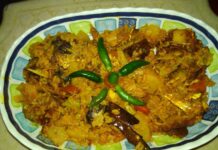Kolkata Dimer Devil-remnants of the Raj
The clubs of Kolkata, once the seat of high British society at the times of the Raj serve a snack item which is not the original and storied food item, but an adaptation of another food item. If you love food that’s all things eggy, then this one will be right up your alley. This Kolkata hybrid of a devilled egg and scotch egg is popularly known in Kolkata parlance as a dimer devil. An egg devil is traditionally not crumb fried, a scotch egg traditionally doesn’t have a filling. In the clubs of Kolkata however, they have been fused to make Kolkata’s very own dimer devil or egg devil. Deviled eggs or dressed eggs are essentially hard-boiled eggs, whose yolk has been removed and the same is used to make stuffing using other ingredients like mayonnaise, mustard, etc, which are then refilled into the egg white. The scotch egg, however, is crumbed version, where a whole egg is wrapped in sausage meat crumbed and then fried or baked. Either way, they are served cold not primarily as a main, but as a side dish or an appetizer.
If we look at origins, the deviled eggs go as far back as the roman empire, when such dressed eggs were served as the first course. A range of exotic ingredients was added to the egg yolk, like caviar, mustard, cheese, various herbs, and even raisins. The poor man would probably just mash it with some potatoes and herbs and spices. The scotch eggs however were more recent in their origin. The London departmental store Fortnum and Mason is often credited as being instrumental in popularizing this item as a traveler’s snack in the 1700s. The origins lying with the raj-styled Narcissus meatballs or the Nargisi kofta is another popular belief. Scotland in the 19th century was one of the largest exporters of eggs, and for transportation, the eggs were scotched or dipped in lime powder which could have been the source of the name. Another belief is that of scorching the eggs or cooking the same on an open flame, where the eggs were actually deep-fried in lard. The origins of the scotch eggs are thus varied and could be any of the above. But the first documentation of this appears in the book “ A New system of Domestic Cookery” penned by Maria Rundell in 1805. The first print reference of the deviled eggs is however from 1786.
The scotch egg is essentially a picnic food or savory appetizer. It is pretty often sold in supermarkets, motorway service stops, and corner shops. Variations where the egg is pickled before being wrapped in the meat also exist. In the US British styled eateries serve these hot instead of cold with ranch dressing or mustard sauce kind of dipping sauces on the side.
As the case may be we will undertake our food journey today with this version of dimer devil while giving out pointers about the original scotch egg. As always the journey starts by raiding the pantry of my mom’s kitchen. To make a serving of about 5 people we will need:
- Eggs 8-10
- Chopped dhania (coriander leaves) ½ tsp
- Milk 4 tbsp
- Minced chicken 300 gms
- Ajmood (parsley) ½ tsp
- Gulmehendi (rosemary) ½ tsp
- Breadcrumbs 100 gms
- Flour 100 gms
- Javitri ground into powder ½ tsp
- English mustard 2 tbsp
- Salt to taste
- Pepper to taste
- Cooking oil
- Water as required
- Potato 2 large (optional)
Now that our visit to the pantry is through, let us roll our sleeves and get busy cooking the eggs. To begin with, we boil the eggs, 6 to 8 depending on the portion size we decide. 2 eggs are set aside for later use during crumbing. If you are looking to make the typical scotch egg, it is nice to leave the yolk a bit runny and you should drop the eggs into ice water straight after boiling in boiling water for 5 to 7 minutes. In case you don’t want it runny let it cool on its own and set it aside.
In the meanwhile, we will prepare the chicken coating for the eggs. In a large bowl add the minced chicken and mix it with the herbs, i.e. Rosemary, parsley, coriander leaves, the mace powder, and 1 tbsp of English mustard. Season this with salt and paper to taste and mix and knead like a dough. This is now portioned into as many eggs as we have.
To make our version of the Kolkata dimer devil we will boil the potatoes and mash them after peeling, season the mash with salt and paper to taste, and set side. Now the eggs are peeled. For the typical scotch egg, we will now cover it with the chicken coating mix we have prepared. But for our version, we will slice the egg length-wise and scoop out the egg yolk. In a mixing bowl, the egg yolk is mashed and seasoned with salt pepper, the remaining mustard (or mayonnaise) till it makes a paste. This paste is refilled in the egg white and sealed with a bit of mashed potatoes in between each half for binding. Alternatively, half of the egg is taken and filled with the egg paste and the remaining half is covered by the mashed potato, giving it a rounded shape and set aside till all the eggs are ready. We will then cover it with the coating
Either way, the traditional or our way, the chicken coating is now taken and spread. The working area is dusted with flour first so that the chicken doesn’t stick. Into this the egg prepared earlier is placed and the coating is spread around the egg, sealing it with the coating. And then again set aside till all the eggs are so covered.
In a mixing bowl, two raw eggs are now cracked and mixed with milk. This is beaten till it becomes fluffy. The covered eggs are now dipped in this egg-milk mix and then crumbed with one layer of a mix of bread crumbs and flour. This is then dipped in the egg-milk mix again and crumbed again. This will ensure an even and smooth coating of the bread crumbs. This is now ready to be fried or baked.
In a wok or a deep pan, add sufficient oil to be able to deep fry and heat it on a high flame. Into this drop the crumbed eggs. Fry them till it’s a golden brown. Remove from oil onto a tissue paper to soak up the excess oil. Garnish and serve.
For the typical scotch egg, where we left the egg yolk runny, the heat of deep frying will make it coagulate a little more so that when you cut into the egg it will not so much as run but just about ooze out. For our version where we made a paste like in the deviled eggs and stuffed it into the egg, the heat will further cook it ensuring the seasoning in the stuffing brings out the taste and aroma in a more marked manner.
A side of onion rings and a dip of mayonnaise will be an excellent accompaniment as you serve these scotch eggs to wow your guests, whether it is as a snack you are serving for an informal gathering or an entrée into a meal. This simple yet endearing and popular egg preparation is a timeless classic, especially in the Kolkata circle. As the case may be a simple dish transcends simplicity to become exquisite in the care you take while making it. At the same time, two of my favorite ingredients that I have learned and pinched from my mom’s way of cooking never fail to help me make any cook into something fantastic. A warm smile warms the food that you cook. Loves melts and blend the ingredients into a heady mix. So when cooking, smile your warmest smile as you enjoy the cook, and drop in a huge dollop of love for the ones you cook for, even if it is just you partaking of the fare you cook. The food will surely be that more tasteful. Bon Apetit






